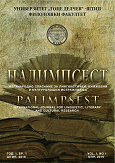HIKIKOMORI: LINGUISTIC ANALYSIS AND TRANSLATION SUGGESTIONS IN ITALIAN LANGUAGE OF A 2.0 NEOLOGISM
Abstract
The paper will examine the word hikikomori through a linguistic analysis: it is referred to as a social phenomenon born in Japan regarding typical adolescents and young adults, also known as social withdrawal: from the Japanese country, which then managed to spread to other industrialized continents, e.g. Europe, until it touched and began to be finally known in various countries, such as Italy. Through this paper, the expression hikikomori will be investigated from a linguistic point of view: first and foremost, a brief story of the term will be described, from the 17th century until nowadays, including the examination of the kanji (ideograms) in which the word used to be and is written, and how it was and is read. The purpose of this paper refers to finding one or more specific translations in the Italian language of hikikomori: in particular, phrasemes have been chosen as a possible translational solution; a [substantive + adjective] structure has been preferred instead of a [substantive + verb] form and, in the end, five possible linguistic phrasemes have been suggested. A fit translation is to be found in eremiti (nativi) digitali or eremiti dell’era digitale: these expressions would be helpful for people who are ignorant in regard to neologisms and words usually labelled as foreignisms. The final goal of this work is for these individuals to fathom and to be familiar with a word typical of 21st century, entered in modern dictionaries.
Keywords: hikikomori, linguistic analysis, neologisms, translation, Italian.
Downloads
References
Articoli e volumi scientifici
Grossmann, M. & Rainer, F. (2004). La formazione delle parole in italiano. Tübingen: Max Niemeryer Verlag.
Heinze, U. (2013). Japanische Blickwelten. Manga, Medien und Museen im Zeichen künstlicher Realität. Bielefeld: Transcript Verlag.
Marchisano, S. & Quaianni Manuzzato, L. M. (2018). Fumetti in una stanza. Hikikomori e NEET nella nona arte. In Distefano, G. V., Guglielmi, M. & Quaquarelli, L. (a cura di), Spazi tra le nuvole. Lo spazio nel fumetto, Between Journal - Rivista dell’Associazione di Teoria e Storia Comparata della Letteratura, 8/15, 1-29.
Masini, F. (2009). Combinazioni di parole e parole sintagmatiche. In Catricalà, M., Pietrandrea, P., Lombardi Vallauri, E., Di Giovine, P., Cerbasi, D., Mereu, L., Gaeta, L., Fiorentino, G., D’Achille, P., Grossmann, M., Jezek, E., Masini, F., Pompei, A., Bonvino, E., Orletti, F. & Frascarelli, M. (a cura di), Spazi linguistici. Studi in onore di Raffaele Simone, 191-209.
Peil, C. (2011). Mobilkommunikation in Japan: zur kulturellen Infrastruktur der Handy-Aneignung. Bielefeld: Transcript Verlag.
Pilz, M. (2011). Vorbereitung auf die Welt der Arbeit in Japan: Bildungssystem und Übergangsfragen. Wiesbaden. VS Verlag für Sozialwissenschaften - Springer Fachmedien Wiesbaden GmbH.
Prandi, M. & De Santis, C. (2019). Manuale di linguistica e di grammatica italiana. Novara: UTET - De Agostini Scuola S.p.A.
Saitō, T. (2013). Hikikomori: Adolescence Without End. Minnesota: University of Minnesota Press.
Dizionari ed enciclopedie
Garzanti Linguistica (2007). Grande Dizionario Garzanti. Varese: De Agostini Scuola S.p.A.
Zingarelli, N. (2019). Zingarelli 2019 - Vocabolario della lingua italiana. Bologna: Zanichelli.
Sitografia e articoli online
Ager, S. (2019) [1998]. Omniglot - the online encyclopedia of writing systems & languages. Consultato il 27 febbraio 2020. https://www.omniglot.com
Ahlström, K., Ahlström, M. & Plummer, A. (2005). Jisho - Japanese-English Online Dictionary. Consultato il 27 febbraio 2020. https://jisho.org
Boccola, N. (2015). Hikikomori, cosleeping e negozi di coccole. Consultato il 9 marzo 2020. http://www.treccani.it/magazine/atlante/societa/Hikikomori_cosleeping_e_negozi_di_coccole.html
Bottacin, G. (2016). Hikikomori, gli eremiti 2.0. Consultato il 9 marzo 2020. https://www.slideshare.net/Giulia_Bottacin/hikikomori-gli-eremiti-20-63544636
Crepaldi, M. (2013). L’hikikomori esiste anche in Italia. Consultato il 6 marzo 2020. https://www.hikikomoriitalia.it/2013/05/lhikikomori-in-italia.html
Crepaldi, M. (2013). Italia: più di 2 milioni di NEET. Consultato il 6 marzo 2020. https://www.hikikomoriitalia.it/2013/06/italia-piu-di-2-milioni-di-neet.html
Crepaldi, M. (2016). Cos’è e cosa NON è l’hikikomori. Consultato il 6 marzo 2020. https://www.hikikomoriitalia.it/2016/02/cose-e-cosa-non-e-lhikikomori.html
Crepaldi, M. (2017). Hikikomori e depressione esistenziale: riflessione sui possibili legami. Consultato il 6 marzo 2020. https://www.hikikomoriitalia.it/2017/07/hikikomori-e-depressione-esistenziale.html
Crepaldi, M. (2018). I falsi miti sull’hikikomori: basta chiamarli eremiti o asociali. Consultato il 6 marzo 2020. https://www.hikikomoriitalia.it/2018/03/hikikomori-i-falsi-miti.html
D’Achille, P. (2017). I social network e la lingua italiana, tra neologismi e anglicismi. Consultato il 5 marzo 2020. http://www.accademiadellacrusca.it/it/scaffali-digitali/articolo/social-network-lingua-italiana-neologismi-anglicismi
Ferroni, E. (2015). Internet-dipendenti: una ricerca lancia l’allarme. Consultato il 4 marzo 2020. http://www.treccani.it/magazine/atlante/societa/Internet_dipendenti_una_ricerca_lancia_l_allarme.html
Greco, C. (2020). Gli hikikomori italiani: quei ragazzi immersi in un eterno presente. Consultato l’8 marzo 2020. https://lab.gedidigital.it/gedi-visual/2020/gli-hikikomori-italiani/?ref=RHRS-BH-I248317395-C6-P2-S1.6-T1&refresh_ce
Istituto dell’Enciclopedia Italiana (2012-2019) [1925]. Enciclopedia Treccani - Enciclopedia / Vocabolario Online / Lessico del XXI secolo. Consultato l‘8 marzo 2020. http://www.treccani.it/
Oxford University Press (2020) [1884]. Oxford English Dictionary (OED). Consultato il 9 marzo 2020. https://www.oed.com/
Pastore, U. (2017). Hikikomori, questi sconosciuti. Consultato il 1° marzo 2020, https://www.animebambu.it/diari-della-mezzaluna/hikikomori/
Pierdominici, C. & Palma, G. (2008). Intervista a Tamaki Saito sul fenomeno "Hikikomori". Consultato il 28 febbraio 2020. http://www.psychomedia.it/pm/pit/cybpat/pierdominici-palma.htm
Rizzo, F. (2016). Hikikomori: The Postmodern Hermits of Japan. Consultato il 2 marzo 2020. http://www.warscapes.com/opinion/hikikomori-postmodern-hermits-japan





